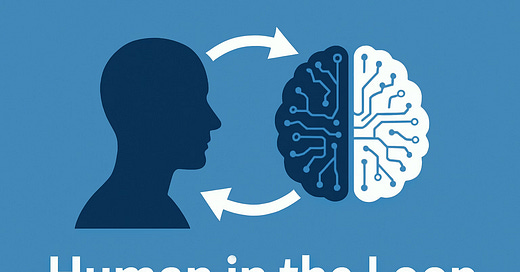Imagine you’ve asked an AI model to draft a critical business proposal, and it generates a complete—but subtly off—document. Without a human reviewing it, that small misalignment could lead to missed opportunities or misunderstandings. This is where Human in the Loop (HITL) becomes not just helpful, but essential.
What Is Human in the Loop?
At its core, HITL refers to the process of having real people engage with, supervise, or correct AI outputs at key stages—whether that means vetting data, validating model predictions, or refining generated content. Instead of fully trusting AI to run unsupervised, we intentionally weave humans into the workflow so that AI can learn from expert feedback and end-users benefit from both machine efficiency and human judgment.
Why HITL Matters
Reducing Hallucinations and Errors Large language models (LLMs) still hallucinate facts up to 15 % of the time. If we left unchecked, these inaccuracies can damage user trust, spread misinformation, or even have serious consequences in highly regulated fields like healthcare. By adding a quick human review—whether through spot checks or a more structured validation process—you can catch and correct errors before they reach end-users.
Incorporating Domain Expertise AI models often lack the nuanced understanding of industry-specific contexts. For example, a medical AI might suggest a treatment plan that is technically plausible but clinically inappropriate. When a certified professional reviews and refines those suggestions, the AI output becomes both accurate and actionable. Over time, the AI can learn from those edits, steadily improving its domain expertise.
Ensuring Ethical and Responsible Use Bias in AI isn’t just a theoretical concern—it shows up in real applications, from hiring tools inadvertently favouring certain demographic groups to chatbots using insensitive language. Human auditors can audit outputs for fairness, spot discriminatory patterns, and adjust data or prompts accordingly. Embedding HITL safeguards helps companies meet ethical guidelines and compliance requirements while avoiding reputational damage.
Improving Customer Trust and Adoption Users understand that a purely automated system may occasionally make mistake. Knowing there’s a qualified human overseeing important decisions builds user's confidence. For instance, an AI-assisted customer support system can draft responses, but when a support agent reviews and personalises the reply, customers feel heard and valued. That hybrid approach often results in higher satisfaction scores and lower user loss.
Real-World Examples of HITL in Action
Financial Services: A wealth-management firm uses an AI model to generate personalised investment summaries. Each summary is automatically flagged for review if it contains less-common financial terms or significant portfolio shifts. A human advisor then validates the recommended allocations and adds any qualitative context—such as explaining market sentiment—before sending it to clients.
Healthcare Diagnostics: Radiology AI tools can highlight potential anomalies in medical images. But a certified radiologist confirms those findings, rules out false positives, and integrates patient history into the final diagnosis. By combining AI’s speed with human expertise, hospitals reduce diagnostic errors and speed up patient care.
Content Moderation: Social-media platforms rely on AI to detect hate speech, copyright violations, and graphic imagery. When the AI model isn’t sufficiently confident—say, it’s unsure whether an image is violent—it routes the content to human moderators who make the final decision according to community guidelines.
Challenges and How to Overcome Them
Scalability: As your user base grows, manually reviewing every edge case becomes impractical. To address this, build semi-automated dashboards that prioritise content by risk score and allow reviewers to batch-process similar issues.
Maintaining Reviewer Consistency: Different humans may apply guidelines inconsistently. Invest in clear documentation, training sessions, and periodic calibration meetings so reviewers have a shared understanding of acceptable outputs.
Cost Considerations: Human reviewers are expensive. Justify the investment by calculating the cost of errors avoided (e.g., legal fines, brand damage) versus the expense of staff time. In many regulated industries, the ROI becomes obvious as soon as you factor in compliance risk.
Looking Ahead: The Future of HITL
As AI models become more capable, the nature of human oversight will evolve. Instead of line-by-line proofreading, humans may shift to higher-level tasks like ethical auditing, strategy alignment, or scenario planning. Meanwhile, AI tools will embed more intuitive “explainability” features—highlighting why they made certain recommendations—so that reviewers can make faster, better-informed decisions.
In other words, we’re moving toward a symbiotic relationship: AI handles scale and speed, while humans bring judgment, empathy, and ethics. That partnership unlocks new possibilities—from personalised mental-health chatbots with licensed therapists in the loop, to fully compliant financial advisors sharing predictive insights with CFOs.
Conclusion
Human in the Loop isn’t a temporary solution—it’s the key of responsible, high-quality AI solutions. By embedding human expertise at critical checkpoints, you reduce errors, uphold ethical standards, and build systems that users trust. Rather than viewing HITL as a drag on efficiency, think of it as a catalyst for better outcomes: AI scales, humans refine, and both learn from each other.
The next time you design an AI workflow, ask yourself: “Where do I need a human’s touch to ensure accuracy, fairness, and trust?” By answering that question thoughtfully, you create AI systems that not only perform—but perform responsibly.
Justin Ju
| AI Engineer at Chelsea AI Venture | justin@chelseaai.co.uk |
If you are interested in implementing AI solutions in your company, please subscribe to this channel. We will be sharing methodologies for implementing AI into business ideas and providing tech solutions to different problems.
At Chelsea AI Venture, we are offering services for scaling up AI in SMEs and we occasionally organise tech training events. Do not hesitate to contact me via email or by visiting our website for any questions or business cooperation opportunities.
If you’re tired of slow, bloated forms—give KirokuForms a try. It is a smart, fast form building solution powered by Chelsea AI Venture. Spin up a free project at KirokuForms and see how fast pure HTML forms can be. Boost your user experience!





